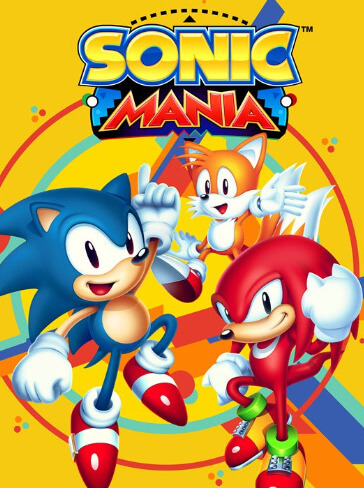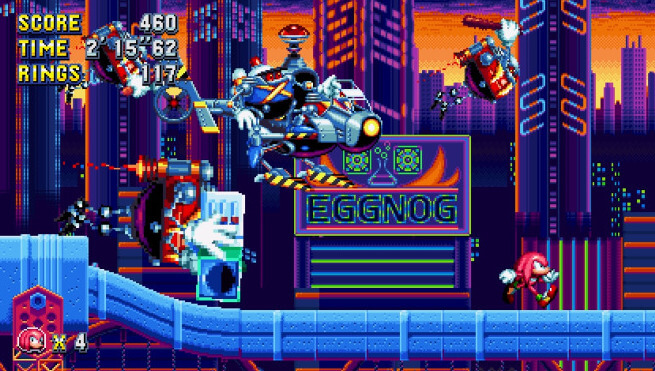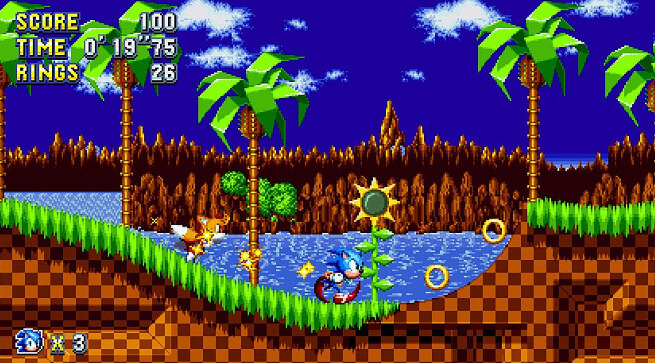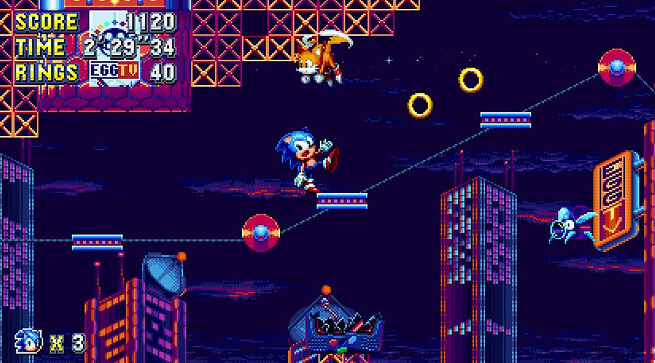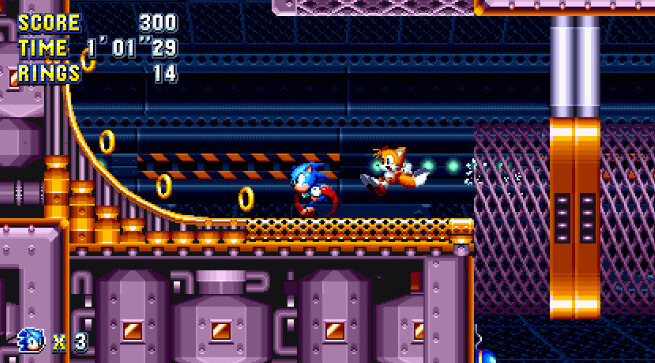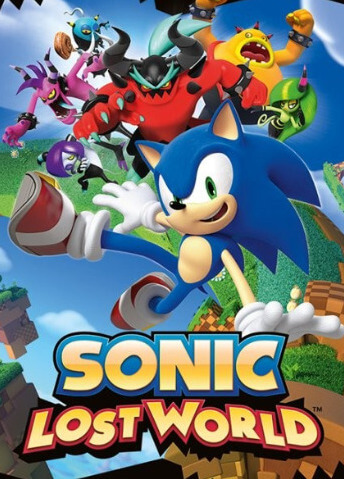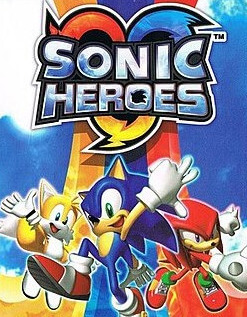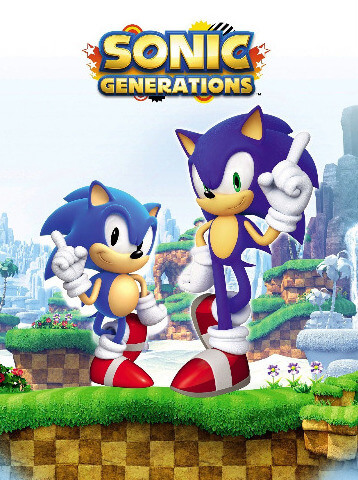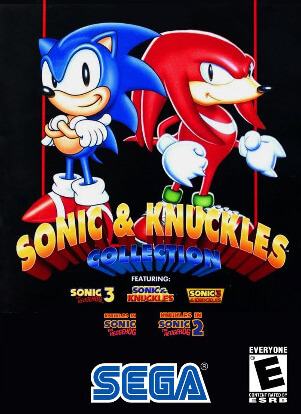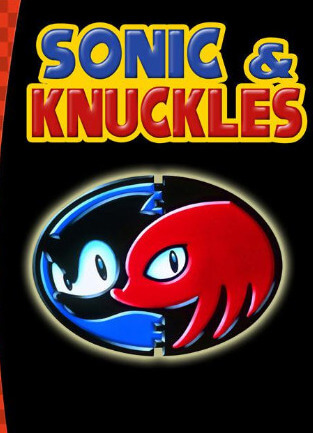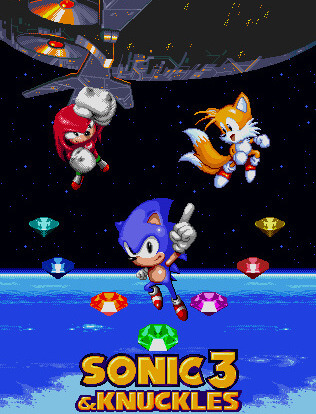Sonic Mania takes place over 12 levels, called zones; the game features 8 "remixed" zones, such as Green Hill Zone from the first Sonic game (1991), alongside 4 original zones. Remixed stages consist of both new elements and recycled gimmicks and ideas from other past Sonic games. Each zone is divided into 2 acts, in which the player must guide their character past various enemies and obstacles to reach the end. At the end of each act, the player takes part in a boss battle against Dr. Robotnik or one of his robots, including the Hard-Boiled Heavies, elite henchmen based on the EggRobo enemies from Sonic 3 & Knuckles. The player collects golden rings, which serve as a form of health; players survive hits as long as they have at least one ring, but, if hit, their rings scatter and disappear after a short time. Television monitors containing rings, elemental shields, or power-ups such as invincibility and faster running speed are scattered throughout each level. Like Sonic 3 & Knuckles, the story is told via short in-game cutscenes between levels.
Giant rings hidden in each act, a feature of the original games, lead to pseudo-3D special stages similar to those in Sonic CD, and act as the special stages where players can attempt to collect a Chaos Emerald. Mania's version of these stages involve players attempting to pursue and catch a UFO carrying an Emerald around a course; each of the seven Emeralds features its own course that has differences in layout and difficulty. To catch the UFO, players can collect spheres that increase their speed, which makes it easier to catch it but requires players to exercise greater control of their character at higher speeds. At the same time, players must collect rings to replenish a ring counter that slowly decreases during the stage, though each course has a finite number of rings available; the counter also decreases rapidly if the player fails to dodge one of the stage's obstacles. All of these stages end when the player either catches the UFO, runs out of rings, or falls off of the course. If the player manages to collect all seven Emeralds during a playthrough of the game, they gain the ability to use their character's super transformation, along with unlocking the game's true ending.
In a time attack mode, players must complete levels as quickly as possible, with the best times included on an online leaderboard; players can instantly reload a level to try again at any time. A split-screen competitive multiplayer mode allows two players to race to the end of a level, similar to those of Sonic 2. Players can also unlock "Mean Bean", a 2-player minigame based on Dr. Robotnik's Mean Bean Machine.
Plot
Following the events of Sonic 3 & Knuckles, Sonic and Tails detect a powerful energy reading on Angel Island and board their biplane, the Tornado, to investigate. However, Dr. Robotnik sends an elite group of EggRobos to reach the signal before Sonic and Tails. The EggRobos excavate the source of the signal, a magical gemstone called the Phantom Ruby, just as Sonic and Tails arrive. The EggRobos gain new powers from the ruby, becoming the Hard Boiled Heavies, and send Sonic, Tails, and the island's guardian, Knuckles, through zones they have previously visited where they pursue Robotnik to prevent him from using the ruby's power for evil, clashing with him and the Heavies along the way.
Sonic and his allies discover that Robotnik has used the Phantom Ruby's power to retake control of Little Planet from Sonic CD. They board Robotnik's robotic fortress, defeat him and the Heavies, and escape just as it explodes. If all 7 Chaos Emeralds are collected while playing as Sonic, the Phantom Ruby transports him and Robotnik to another dimension. There, the Heavy King betrays Robotnik and takes the ruby, imbuing himself with power; Robotnik attacks the Heavy to try to reclaim it. Sonic uses the Chaos Emeralds to become Super Sonic and fights Robotnik and the Heavy King separately to keep the ruby out of the possession of both. After the battle, the Phantom Ruby reacts with the Emeralds, negating Sonic's super state and creating a wormhole that engulfs itself and Sonic as Little Planet vanishes.
Reception
Sonic Mania was announced following years of mixed reviews for the Sonic franchise. According to the International Business Times, the series had been "tarnished by years of sub-par games with only the occasional gem". The Business Times predicted that Sega's approach of releasing Sonic Forces and Sonic Mania in the same year, catering to new and old fans, could repair the series' reputation and lead to a "Sonic renaissance". Several critics expressed excitement for a return to the style of the early Sonic games, and wrote that Sega's previous efforts to develop games in the "classic" style, such as Sonic the Hedgehog 4 in 2010, had been disappointing.
According to review aggregator site Metacritic, Sonic Mania received "generally favorable" reviews. It became the best-reviewed Sonic game in fifteen years, and several critics described it as one of the best 2D platform games. At launch, Sonic Mania was the bestselling Switch game, outselling Minecraft and Overcooked: Special Edition. It greatly increased Sega's third-quarter profits, and helped Sega almost double sales of packaged games compared to the same period in 2016. By April 2018, it had sold over one million copies worldwide across all platforms.
The presentation attracted acclaim. USGamer described it as the "pinnacle" of the series' pixel graphics. GameSpot called the animations and detail superior to the original games, writing that they added an extra layer of personality. Cubed3 described the levels as stylish and vibrant. Critics also praised the attention to detail in recreating the early games. Game Informer wrote that its gameplay was "nearly indistinguishable" from its Genesis predecessors, but with "extra polish". Easy Allies wrote that Mania emulated the original games "exceptionally", and that "running, jumping, and spin dashing all work exactly as well as you would hope". Nintendo World Report wrote that it avoided the physics problems from Sonic the Hedgehog 4 and recaptured the spirit of the 16-bit games.
The level design and music also received praise. Hardcore Gamer wrote that the remixed versions of older stages felt fresh while staying true to the originals. Game Informer wrote that the new stages matched the quality and captured the spirit of early Sonic games. The A.V. Club praised the detail and content in each level; Metro praised the fanservice, and likened it to a school project "gone wild, something enthusiastic kids have made while the teacher was away and which far surpasses anything they were actually supposed to be doing". Like IGN, Venture Beat appreciated the replay value, with branching paths that made multiple playthroughs "fresh". EGM wrote that the soundtrack was "completely fantastic" and felt nostalgic and new at the same time. Nintendo Life called the soundtrack "one of the best of recent times".
